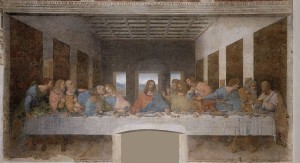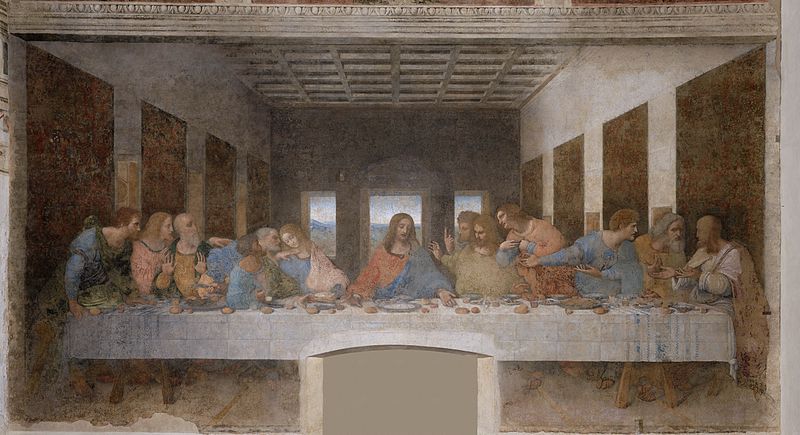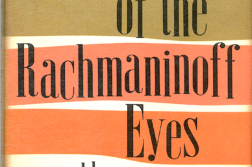IN 2003, the controversy over The Da Vinci Code by Dan Brown arose from, among other things, the book’s claim that the Catholic Church encodes forbidden knowledge in its images. An instance of this secret practice is supposedly how, in Leonardo da Vinci’s The Last Supper, there appears to be a blonde female figure seated at Christ’s right that we have always mistakenly accepted as John the Evangelist. Brown’s novel posits that the figure is really Mary Magdalene, the woman with whom, according to some traditions, Jesus was sexually intimate.
Officially, the Catholic Church denies any such relationship. Still, it contradicts Mr. Brown only in terms of Church history. On the other hand, Leonardo did encode the painting— but not to hide secret Church knowledge. My contention is that Leonardo encoded his own particular homosexuality in the painting. The androgynous figure inserted into one of the most sacred images of Catholic theology attests to the artist’s attraction to the youth who’s pictured there.
To give an example of how this encoding worked for Renaissance artists: the Metropolitan Museum of Art possesses a painting by Botticelli, The Last Communion of Saint Jerome (dated 1495), which shows the saint on his knees before a handsome young priest who’s about to place a communion wafer on the old man’s tongue. The homosexual context is plainly apparent, though Botticelli came under the reforming authority of the monk Savonarola, who in 1494 had ordered the priests of Florence to abandon their passion for beardless youths. Furthermore, in 1502, long after Savonarola’s reign, Botticelli was anonymously denounced to the Florentine authorities as a sodomite. Previously, on April 9, 1476, and on June 7, 1476, Leonardo had had to face similar charges. In both cases, the accused men escaped penalties that could have varied from a fine to castration.
 Despite the laws against homosexuality, “the unmentionable vice” persisted so widely in Florence that the authorities had to institute sterner measures against it in 1502 and 1506. There was a widely acknowledged type of homosexual relationship at this time, one that always included a mature man and an adolescent boy. The younger partner was seen to combine both male and female attributes as he slowly developed into full manhood.
Despite the laws against homosexuality, “the unmentionable vice” persisted so widely in Florence that the authorities had to institute sterner measures against it in 1502 and 1506. There was a widely acknowledged type of homosexual relationship at this time, one that always included a mature man and an adolescent boy. The younger partner was seen to combine both male and female attributes as he slowly developed into full manhood.
While Leonardo did leave some fairly explicit drawings, there is no definitive proof of homosexual activity per se. However, the painter’s images are consistent with those of an artist with a vivid homosexual imagination. His depiction of androgynous males indicates a willingness to make use of a Renaissance convention for a certain kind of homosexual relationship. During the Renaissance, the appeal of the androgynous youth was sometimes expressed in the clichés of platonic pure love for a boy, but sometimes homosexual desire appeared in the more mundane terms of a mature man’s attraction to a vigorous youth. These two approaches appear in Michelangelo’s use of idealized, muscular models while professing pure love for a youth named Tomasso Cavalieri.
Leonardo da Vinci’s expression of homosexuality somewhat opposed Michelangelo’s platonic strategies. Wrote Leonardo in The Notebooks: “Man and animals are merely a passage and channel for food.” And he cautioned: “Poor rather is the man who desires many things.” Unlike the choleric Michelangelo, Leonardo kept his feelings under control. Despite Leonardo’s refined social graces, he sought to avoid for the most part casual interaction with other people, and he kept his personal and material attachments to a minimum. Leonardo believed that “while you are alone, you are entirely your own, and if you have one companion, you are half your own, and the less so in proportion to the indiscretion of his behavior.”* Yet, Leonardo also wrote, “Love conquers all.”
Nevertheless, Leonardo did form a series of attachments with his handsome assistants. The most notorious of them was Gian Giacomo de’ Caprotti, called “Salai” by the painter, meaning “Satan.” The artist knew that this beautiful, curly-haired child stole, lied, and cheated. Nevertheless, he took Gian with him on his travels, provided his sister with a dowry, and bestowed a livelihood on his father. Salai stayed with Leonardo for 26 years. The artist sketched Salai many times, strongly hinting at a physical attraction. Leonardo’s “type,” if one can apply this term, appears to have been a man who embodied what one art historian has called “the feminine spirit of mystery and grace.”† This is why in one of his last paintings, St. John the Baptist, which now hangs in the Louvre, the feminized prophet exhibits an enigmatic expression while pointing a finger upwards toward heaven. He is the same physical type that the painter added to The Last Supper to represent John the Evangelist. This is the apostle who could write about himself that he was “the disciple whom Jesus loved” (in John 13:23 and in three other passages).
In the painting, Leonardo encodes his homosexuality by depicting a love about which the painter had decidedly mixed feelings. While in the Gospel John announces his love for Jesus in terms of a disciple’s love for his teacher, in The Last Supper Leonardo includes the androgynous figure in order to confess a personal moral failing. If we take Leonardo at his word, then the painting represents this sentiment: “Neither promise yourself things nor do things if you see that when deprived of them they will cause you material suffering. This by experience is proved that he who never puts his trust in any man will never be deceived.” By these words, Leonardo hints that he despairs of love because he suspects that surrender to it will lead to betrayal and suffering.
The generally accepted source of Leonardo da Vinci’s Last Supper is the Gospel according to Saint Matthew (Matt 26:21), where Judas asks if he is the traitor. Some critics have argued that the painting’s inspiration is Christ’s announcement to the gathering that there is a traitor among them. However, it seems to me that John 13:22 expresses Leonardo’s homosexual sensibility and expands on St. Matthew’s version. The Last Supper depicts the moment when John discovers the terrible destiny of his Master. It defines John’s future life as the Savior’s faithful, lifelong mourner. The Apostle demonstrates this constancy when, in the Gospel, he emphasizes how he outruns Peter to gaze in on the resurrected Christ’s empty tomb (John 20:1-4).
Earlier, when Jesus warned that one of the disciples would betray him, John leaned forward toward Jesus. In Leonardo’s painting, however, John has moved away from Christ. In this new tableau, both John and Jesus seem to retreat inward to be with their thoughts. It seems that Leonardo is depicting how John suffered in his soul. Leonardo’s Evangelist quietly ponders the painful mystery that unfolds before him. This feminine gesture appears in the Gospel according to Saint Luke, when the Virgin contemplates what is to come (Luke 2:51). It is also suggested in Saint John’s Gospel when the saint writes that Jesus contrasts a mother’s birth pangs to her later joy (John 16:20-21). So, John’s stillness could be an emotional confession of love that agrees with same-sex love as Leonardo understood it. Leonardo offers an image of the consequences of being fully human, which is to say, capable of love. In this respect John’s surrender to suffering represents, as it does for the Virgin, the power of love.
In the Gospel, John records Christ’s farewell: “I came forth from the Father and have come into the world. Again, I leave the world and go to the Father” (John 16:28). The life that awaits John appears further on in the text: “These things I have spoken to you, that in Me you may have peace. In the world, you will have tribulation; but be of good cheer, I have overcome the world” (John 16:33). This depiction of the surrender to the experience of male-male love as Leonardo understood it generates the intense veneration of an image that’s still so popular as to be almost kitsch. So, Dan Brown’s reliance on the expressive power of The Last Supper as a point of reference for his claim that the Catholic Church encodes a mystery in art is not incorrect. However, Brown misses the point, and far be it from the Catholic Church to correct him.
* Wittkower, Rudolf and Margot. Born Under Saturn. The Character and Conduct of Artists: A Documented History from Antiquity to the French Revolution. W. W. Norton, 1963.
† Clark, Kenneth. “Leonardo and the Antique.” Leonardo’s Legacy: An International Symposium. Edited by C. D. O’Malley. Univ. of California Press, 1969.
Rolando Jorif teaches English at CUNY.





